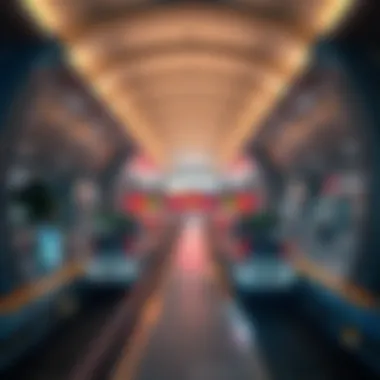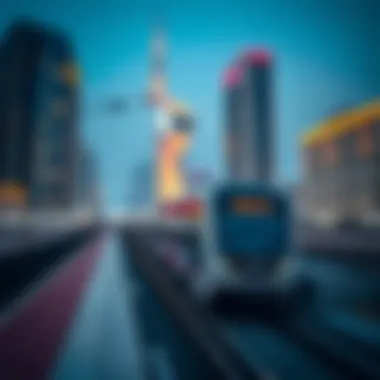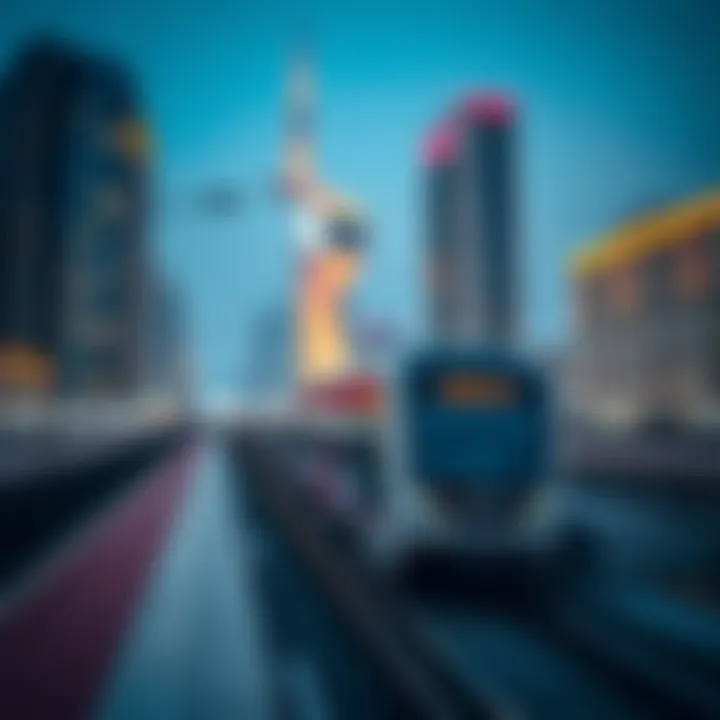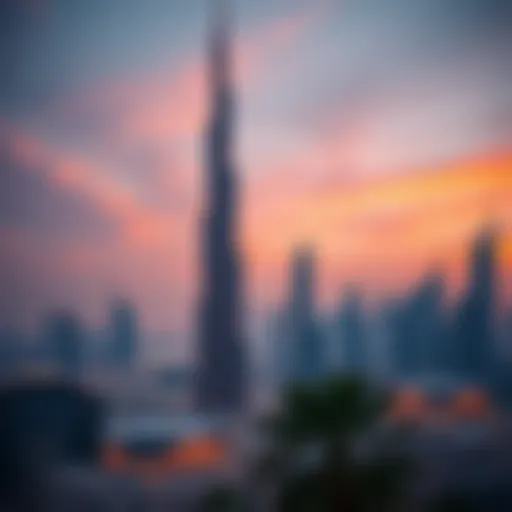Impact of International City Metro on Dubai's Growth


Intro
The public transportation landscape in any bustling metropolis plays a significant role in shaping the economic and social dynamics of the area. In the case of Dubai, the International City Metro serves as a linchpin in the urban development strategy. With its intricate network, it connects various neighborhoods, enhancing accessibility and invigorating the real estate market. The metro not only facilitates mobility for residents and visitors alike but also has implications for investment opportunities and urban planning. As we dissect this transport network, a clearer picture emerges regarding its current impact and future potential in the rapidly evolving Dubai landscape.
Market Overview
Current Trends
The International City Metro has become a vital part of Dubai’s ambition to position itself as a global transport hub. Recent trends show that ridership is increasing steadily, influenced by residents seeking convenient means to access jobs, shopping, and leisure activities. Digital innovations are playing a central role as well, with integration of mobile applications for real-time updates and ticketing, appealing particularly to tech-savvy users.
Additionally, we observe a gradual shift towards more sustainable forms of transport. Policies promoting eco-friendly travel options, including electric buses and hybrids, are gaining traction, complementing the metro's own green initiatives. This shift resonates well with the environmentally-conscious resident and tourist alike.
Forecast and Predictions
Looking ahead, the outlook for the International City Metro appears promising. Analysts predict continued expansion, with plans for new routes and enhancements to existing lines. By 2025, it is expected that ridership could increase by 30%, driven by ongoing urban development projects and an influx of expatriates.
Real estate experts suggest that properties near metro stations are set to appreciate considerably, creating a ripple effect across the housing market. As more residents are drawn to these areas for their convenience, urban density will increase, posing both opportunities and challenges for city planners and investors.
Investment Opportunities
Residential Properties
Investors are eyeing the apartment complexes and villas that line the metro route. Properties in close proximity to stations are often regarded as prime real estate, with rental yields and resale values steadily climbing. For example, areas like Mirdif and International City are becoming hot spots, thanks to their accessibility via metro. Investors can expect significant returns, especially with the ongoing development initiatives that aim to enhance livability and community features further.
Commercial Ventures
On the commercial front, businesses are increasingly drawn to locations near metro stations, recognizing the potential for foot traffic and visibility. Retail spaces, cafes, and offices benefit from the metro's bustling activity. As Dubai positions itself as a business-friendly environment, commercial real estate investments near transportation hubs are becoming more attractive.
In summary, the International City Metro is not merely a transit system; it is a catalyst of urban change with immense potential for those ready to invest in its future.
"The metro's influence is woven through the fabric of Dubai, propelling economic growth while ensuring connectivity and mobility for all."
As we continue to explore this dynamic transport network, it becomes evident how integral it is to the economic input and overall functioning of Dubai's modern-day society.
Further Reading
For more insights on Dubai's public transport and urban planning, consider visiting:
Prelude to the International City Metro
Understanding the International City Metro is pivotal in discussing the broader topic of Dubai's public transport and urban planning. The metro system serves as a backbone of the city’s public transportation infrastructure, shaping not just the daily commutes, but also the very fabric of urban life in Dubai. It is an innovative response to the rapid urbanization and population growth in the region.
As an essential element of public transport in Dubai, the metro connects various neighborhoods and residential areas, providing commuters with an efficient and effective means of travel. For investors and homebuyers, the metro’s proximity to residential and commercial areas can significantly influence property values and purchasing decisions. The expansion and operation of the metro system underscore Dubai's ambition to modernize its infrastructure and enhance the overall quality of life for its residents.
Moreover, the International City Metro isn't only about getting from point A to B; it is a decisive part of the city’s strategy to reduce dependency on private vehicles, contributing to less traffic congestion and lower carbon emissions. This ties directly into the global shift towards sustainability, making it vital for stakeholders in the real estate sector to recognize these dynamics and adapt their strategies accordingly.
With the International City Metro making waves, understanding its mechanics and implications allows us to glean insights into urban development trends and investment opportunities that arise within this unique urban landscape.
Overview of Public Transport in Dubai
Dubai’s public transport system has expanded significantly over the past few decades, transforming the way residents and tourists navigate the city. At the heart of this evolution is a comprehensive network that includes metro trains, buses, and water transportation, enabling seamless connectivity throughout the emirate.
- Metro System: The metro lines are a marvel of modern engineering, featuring air-conditioned carriages that accommodate thousands of passengers daily. The Red Line and Green Line cater to high-traffic areas, ensuring efficient transport to major business districts and residential neighborhoods.
- Buses: The bus network complements the metro system, connecting areas that are not serviced by trains. Buses are often timed to meet metro schedules, providing a cohesive transit experience.
- Water Transport: Dubai also harnesses its waterways through abras, ferries, and water taxis. These unique modes of transport offer picturesque views of the skyline while providing vital connections.
The integration of these systems not only eases daily commutes but also showcases Dubai’s commitment to making public transport a convenient and attractive alternative to private vehicles.
Significance of the Metro System
The metro system holds remarkable significance in shaping Dubai's transport landscape.
- Economic Growth: By enhancing connectivity, the metro attracts businesses and tourists alike, fostering economic activities across various sectors. Investors looking into commercial properties near metro stations often witness increased demand, leading to favorable returns on investment.
- Urban Development: The metro has encouraged urban development in and around its stations. This development often includes residential units, retail outlets, and office spaces, creating vibrant community hubs. The interconnectedness promotes a more livable city, where residents can enjoy the convenience of having work, leisure, and transport options in proximity.
- Sustainability Efforts: By reducing traffic congestion and greenhouse gas emissions, the metro aligns with Dubai's sustainability goals. This approach not only benefits the environment but also improves public health and the overall quality of urban life.
The metro's implications reach far beyond mere transportation; it represents a transformative initiative that shapes Dubai's urban landscape and elevates it as a global city. By analyzing these facets, one can appreciate how critical such transportation frameworks are for future urban planning and real estate strategies.
Historical Context of Metro Development
When discussing the International City Metro in Dubai, it's key to understand the historical backdrop of the metro system's development. This narrative provides a rich context for understanding not just why this infrastructure was constructed, but how it reshaped Dubai’s landscape over the years. By tracing the origins and growth of the metro system, one can appreciate its significance to urban planning, economic growth, and social mobility in a region that has transformed rapidly.
Timeline of Metro Construction
The journey of the metro construction in Dubai is a tale of visionary planning and ambitious execution. It kicks off formally in 2005, under the banner of the Dubai Roads and Transport Authority (RTA). This period marked the beginning of a fresh approach to public transportation in a city previously dominated by personal vehicles.
- 2005: The project receives the green light, aiming to create a solution for growing urban congestion and to enhance public transport attractiveness.
- 2009: The Red Line opens on September 9, an important milestone that set the tone for future expansions. This inaugural line spanned an impressive 52.1 kilometers, connecting key districts and facilitating better access to various parts of the city.
- 2010: The Green Line follows suit, inaugurated in August, catering to areas less served by the Red Line, effectively enhancing connectivity for residents.
- 2011 and Beyond: Subsequent expansions and phases continued well into the late 2010s, demonstrating the government’s commitment to improving public transport. Ongoing projects aimed to integrate more neighborhoods and support Dubai's burgeoning population.


These developments were not just about connecting distances; they symbolized a shift towards sustainable urban development, paving the way for a modern metropolis.
Milestones Achieved
The milestones achieved throughout the metro's development are impressive, reflecting the ambitious goals set forth at the outset. Several noteworthy landmarks are worth emphasizing:
- Implementation of Automated Trains: One of the striking features of Dubai's metro is its fully automated, driverless trains. This was not just a technological achievement; it also paved the way for increased operational efficiency and safety.
- International Recognition: By 2015, the Emirates' metro system gained international acclaim, being recognized in various reports as one of the most advanced in the world. This showcase of innovation elevated Dubai’s status on the global stage.
- Integration of Multi-Modal Transport: In its expanding timeline, the metro system successfully integrated with other modes of transport, like water taxis and buses, enhancing overall mobility and offering commuters flexible travel options.
- Boost in Ridership: Over the years, ridership figures surged dramatically, reaching millions annually, showcasing the metro's effectiveness in reshaping commuting habits and preferences among the local population.
"The development of the Dubai Metro stands as a testament to thoughtful urban planning, tightly aligning transportation needs with sustainability goals."
As the metro continues to evolve, it faces the task of not only maintaining these established achievements but also adapting to the changing dynamics of urban life in Dubai. The narrative of historical development is not merely a recounting of dates and milestones; it highlights a vision for a city that embraces progress while addressing the challenges of a growing population and urban density. By understanding the context and evolution of the metro system, stakeholders can better appreciate its ongoing impact in shaping Dubai's urban landscape and economic future.
For additional insights, you can refer to resources like Wikipedia on Dubai Metro or Britannica. These platforms provide extensive details on the engineering marvels and operational standards involved in the development of the metro.
Operational Mechanics of the Metro System
The operational dynamics of the metro system is crucial in understanding the broader impact it has on Dubai's urban environment. A well-functioning metro serves not just as a means of transportation, but as a backbone that supports the socio-economic activities of the city. It connects communities, boosts real estate values, and transforms daily commutes, bringing significant benefits to both residents and investors alike.
Route Structure and Connectivity
The route structure of the International City Metro is meticulously designed to connect various urban hubs, facilitating seamless travel across the city. Each station is strategically located to enhance accessibility, ensuring that commuters can easily access key areas such as business districts, tourist attractions, and residential neighborhoods. For instance, the metro line stretches from key entry points at the Dubai Airport to the vibrant neighborhoods of Deira and Bur Dubai, allowing residents to navigate the city effortlessly.
A well-structured route enhances connectivity significantly. This connectivity leads to increased foot traffic in areas near metro stations, thereby enhancing real estate values and creating a ripple effect on local businesses. Customers are more likely to frequent shops and restaurants that are easily accessible by metro. Furthermore, the integration with other transport options, such as buses and taxis, means commuters can enjoy a smoother transition from one mode of transport to another.
Effective route structure ensures that the metro is not just a means of transport, but a catalyst for urban development.
Technology Integration in Operations
The adoption of cutting-edge technology plays a pivotal role in the efficiency of the metro system. From automated ticketing systems to real-time service updates, technology enhances the overall commuter experience. Smart apps have been developed that allow users to plan their journeys in advance, giving them accurate travel times and alternative routes when necessary.
Control systems enable the monitoring of train schedules and crowd management, ensuring trains run efficiently and on time. Integrating Artificial Intelligence and big data analytics not only improves operational efficiency but also helps in forecasting demand trends. This foresight is essential for planning future expansions and enhancing current services to meet users' needs better.
Additionally, introducing digital ticketing has made the previous cumbersome process of acquiring tickets quick and user-friendly. Commuters can use contactless cards or mobile apps to pay fares, drastically reducing wait times at stations.
Safety and Security Measures
Safety and security are paramount in any transport system, and the International City Metro has implemented robust measures to safeguard passengers. CCTV cameras are installed throughout the stations and on trains, providing a constant stream of surveillance. Trained security personnel patrol the premises to ensure a safe environment for all commuters.
Regular maintenance checks of the trains and infrastructure ensure that technical issues are addressed before they become significant problems. Emergency response protocols are in place, with emergency exits clearly marked and accessible. In case of unforeseen incidents, staff members are trained to guide passengers to safety without panic.
Moreover, awareness campaigns about personal safety while traveling on the metro train are conducted, which contributes to a more secure commute. All these elements together create an atmosphere of trust and security, vital for increasing ridership and fostering a sense of community.
Impact on Urban Mobility
The International City Metro in Dubai has fundamentally reshaped how residents navigate their urban environment. This metro system serves as a lifeblood, creating a new fabric of connectivity that enhances mobility throughout the city. Its significance extends beyond mere transportation; it plays a pivotal role in environmental sustainability, economic vitality, and improved quality of life for users. This section elucidates the impact of the metro on urban mobility by exploring its capability to reduce traffic congestion and enhance daily commutes for Dubai’s citizens.
Reduction in Traffic Congestion
Dubai, known for its sprawling landscapes and rapid development, faces a perennial challenge with traffic congestion. The increasing number of vehicles on the roads has led to gridlock conditions during peak hours, affecting productivity and causing commuter frustration. The International City Metro stands out as a viable solution to alleviate this pressing issue.
By providing a reliable alternative to road travel, the metro encourages residents to leave their cars at home, significantly cutting down the volume of vehicles on the roads. For instance, research indicates that for every commuter switched to metro, the reduction in road traffic can be substantial. In practical terms, fewer cars means less carbon emissions and improved air quality. The integration of metro services also promotes efficiency, as public transport typically serves more passengers compared to individual cars, which can often be underutilized.
"Investing in public transport is investing in the future; we are not just moving people, we are changing lives."
Moreover, the metro’s strategically planned routes connect key districts and neighborhoods, fostering better accessibility to essential services. This connectivity not only helps in flattening traffic but also brings about a social change where people from diverse backgrounds can share the same space in transit, thus enhancing community spirit.
Enhancing Daily Commutes
Daily commutes can often be mundane and tedious, but the metro system promises to turn that around. With its efficient scheduling and modern facilities, riding the metro has transformed into a seamless experience for many.
With stops at vital locations such as business hubs, shopping centers, and cultural sites, commuting no longer feels like a chore. The journey from International City to Downtown Dubai can take less than twenty minutes during off-peak hours, a stark contrast to the potential hours one might spend in traffic. The time saved translates into more opportunities for leisure or family engagements, significantly enriching the quality of life.
Accessibility features within the metro, including escalators and designated seating for those in need, ensure that everyone can make the most of this system. These additions demonstrate Dubai's commitment to inclusivity, ensuring that individuals with disabilities can freely access essential locations without facing mobility barriers.
The metro system also integrates modern amenities such as free Wi-Fi and real-time tracking systems through mobile apps, providing commuters with a level of convenience that enhances their daily experiences. This technological integration allows users to plan their journeys effectively, thereby reducing wait times and improving overall satisfaction.
In summary, the International City Metro serves not just as a mode of transportation but as a catalyst for urban transformation. Its ability to lessen traffic woes and uplift the daily commute experience stands as a testament to its importance in shaping a more connected and mobile Dubai.
Socio-Economic Implications
The integration of the International City Metro system into Dubai's urban fabric presents profound socio-economic implications that resonate throughout the entire region. Beyond mere transportation, the metro serves as a pivotal catalyst, shaping demographic trends, facilitating business growth, and enhancing the quality of life for its residents. Understanding these implications is crucial for stakeholders ranging from investors to potential homebuyers, as it offers insights into the future landscape of the metropolitan area.
Changing Demographics and Living Patterns
The advent of the metro has influenced living patterns in notable ways. For instance, the ease of transportation encourages residents to explore previously neglected areas. More families and young professionals are opting to live farther from traditional business hubs, seeking more affordable housing options in places like International City, which is now more accessible through metro links.


People tend to gravitate towards neighborhoods where public transport is robust, thinking long term about where they intend to live. Proximity to metro stations can increase a neighborhood's attractiveness, attracting a more diverse demographic mix. The movement is not just towards affordability; there’s a cultural shift, too, as areas become hubs for different communities celebrating their backgrounds and traditions in new and vibrant ways.
Moreover, the demographic changes alter consumer habits. With a new influx of residents who prioritize convenience, businesses are adapting to cater to these increased demands. New establishments like cafes, grocery stores, and entertainment venues are sprouting within walking distance of metro stations, reflecting the evolving needs and preferences of the population.
The metro isn’t merely about getting from point A to point B; it’s about reshaping the very fabric of society by changing where people choose to live and work.
Effect on Local Businesses
Local businesses have found themselves navigating a new landscape created by the metro system. The improved foot traffic and accessibility provide greater opportunities for entrepreneurs. Areas adjacent to metro stations are now prime real estate for shop owners, restaurants, and service providers. Recent studies indicate a marked increase in retail sales and service usage in neighborhoods served by the metro.
- Increased Customer Base: Businesses situated near metro stops have reported a surge in customer volume, thanks to the influx of commuters. An additional advantage is that many metro users are tourists or expatriates who might not have otherwise ventured into these neighborhoods.
- Collaborative Opportunities: Local businesses are increasingly participating in joint marketing initiatives, capitalizing on the growing numbers of commuters. Events or promotions tied to the metro can attract even more clientele.
- Adaptation and Evolution: There’s a noticeable shift in how businesses design their services; faster service and convenience have become selling points. Additionally, some businesses are adjusting their hours to cater to the typical commuter schedule, extending to late-night services.
This symbiotic relationship between the metro and local businesses underscores the economic vitality that comes with a strong public transportation network. It’s a promising indicator for future investment, illuminating areas that are likely to thrive in the years to come.
In summary, the socio-economic implications of the International City Metro in Dubai extend far beyond transportation, influencing living patterns, enhancing community diversity, and providing fresh avenues for local businesses. These changes signal a transformative era for the city, creating a dynamic urban environment that reconciles convenience with quality of life.
Real Estate Trends Influenced by the Metro
The advent of the International City Metro has become a game-changer for Dubai’s real estate landscape. The metro system has not just transformed how individuals navigate the city but has also notably altered property dynamics, encouraging a fresh wave of investment and development. In this section, we will explore how the introduction and expansion of the metro influence property value fluctuations and create compelling investment opportunities.
Property Value Fluctuations
The relationship between metro access and property values is a classic case of supply and demand where proximity to a metro station can make or break a residential or commercial development. For instance, properties located within walking distance of a metro stop often see an uptick in value as buyers and renters prioritize accessibility. Commuters can save time and money, turning these locations into desirable hotspots.
Several studies suggest properties near metro stations can yield 10% to 30% higher prices compared to similar properties further away from public transport. This trend is particularly pronounced in regions experiencing urban sprawl, where convenience becomes a key selling point.
As the metro lines extend to new developments—be it a gleaming high-rise or a cozy townhouse—property owners and developers that recognize this correlation can capitalize on enhanced visibility and attractiveness to potential buyers. The media has reported how areas like Jumeirah Village Circle have seen significant growth in property values since the metro lines were announced.
"The metro is more than just a transit system; it’s become a financial compass guiding the direction of property investments in Dubai."
Additionally, socio-economic factors play a role in these fluctuations. Demographics shift—like an influx of young professionals seeking affordable housing close to transport hubs—can drive demand and, consequently, property values.
Investment Opportunities Created
Investors looking at the Dubai real estate market can find numerous pathways opened by the International City Metro. The notion is straightforward: areas serviced by the metro are more appealing to a wider range of buyers. Not only does public transport ease commutes, but it also fosters a community-oriented environment.
Some notable investment opportunities include:
- Mixed-use developments: With the favorable policy environment and urban planning, creating spaces where people can live, work, and play is increasingly viable.
- Commercial spaces: Shops, restaurants, and offices near metro stations can thrive—given the foot traffic generated by commuters.
- Co-living arrangements: With rising housing costs in other parts of Dubai, shared living spaces near metro lines present a lucrative option for both investors and residents seeking economical living solutions.
The metro also increases property liquidity. An investment in a metro-adjacent property can allow a quicker sale, as demand continues to skyrocket among eager tenants and buyers. Moreover, investors may partake in government incentives aimed at regions serviced by the metro, indirectly boosting their returns.
In summary, both current homeowners and potential investors should pay attention to property trends related to metro developments. By monitoring emerging neighborhoods and tapping into the market where the metro influences connectivity, they can make informed decisions that align with the ongoing transformation of Dubai's cityscape.
Future Developments and Expansion Plans
The Future Developments and Expansion Plans of the International City Metro are instrumental to Dubai’s vision of becoming a global hub. As the city continually evolves, so does the need for enhancements in its transportation network. Planned expansions not only aim to boost connectivity but also enhance the metro's role in urban planning and development.
Expanding the metro routes can significantly influence various sectors, especially real estate and tourism. The anticipated projects cater to a growing population and the increasing demand for efficient public transport options. Therefore, understanding these plans is essential for investors, homebuyers, and urban planners alike, as they outline the trajectory of infrastructure advancement in Dubai.
Upcoming Routes and Services
Dubai's metro network is set to see several new routes and services that will further integrate the system into the daily lives of residents. Among the major additions, the Expansion of Route 2020 stands out. This route is designed to connect the metro to the Expo 2020 site and nearby residential areas, significantly elevating accessibility for both locals and tourists alike. The expected completion of this route in 2024 will be a game-changer, opening the doors to improved traffic management and travel efficiency.
In addition to Route 2020, plans are underway for further expansions into the northern parts of the city. One prominent proposal includes extending the metro towards Al Maktoum International Airport, which could not only ease travel to and from the airport but also spur economic growth in surrounding areas. Such services not only provide convenience but also intertwine with the city’s broader goals of sustainability and urban growth.
While these plans are ambitious, they bring the promise of enhanced service frequency, technological upgrades, and accessibility improvements. The introduction of Smart Card Systems for seamless fare integrations is also on the horizon, revolutionizing the way riders interact with the metro system.
Integrating Sustainable Practices
Sustainability remains at the heart of Dubai's vision for its metro system's future. As the city embarks on these expansion plans, it simultaneously emphasizes integrating sustainable practices to reduce its carbon footprint and promote environmental stewardship.
In this light, projects are increasingly focusing on energy-efficient technologies. The adoption of solar panels on metro stations and trains could significantly cut energy consumption. Moreover, utilizing green building standards for constructing additional stations ensures that the metro expansion aligns with the UAE's sustainability goals.
Another noteworthy approach is the promotion of biophilia in design. Future stations may feature green walls and terraces that not only enhance aesthetic appeal but also improve air quality. Creating a healthier environment is paramount as residents spend considerable time commuting to work or leisure.
The impact of these sustainability measures will resonate beyond the metro system. They contribute to a substantial decrease in overall vehicular traffic, which consequently promotes cleaner air and a healthier lifestyle for residents. The integration of eco-friendly practices in public transport systems will position Dubai as a leader in sustainable urban transport solutions.
"An efficient metro system is the pulse of a city, connecting people not just physically but also in their desire for a sustainable future."
Challenges and Limitations
Understanding the challenges and limitations of the International City Metro in Dubai is essential for a comprehensive overview of its effectiveness and future prospects. While the metro system has transformed urban commuting significantly, it is not without its flaws. Addressing issues like capacity, overcrowding, maintenance, and operational costs is crucial for continued success. These factors play a pivotal role in shaping user experiences and influencing public perception. Moreover, an objective analysis aids stakeholders, including investors, homebuyers, and local businesses, in making informed decisions.
Capacity and Overcrowding Issues


A crucial challenge facing the International City Metro is capacity management, particularly during peak hours. The influx of commuters can lead to crowded conditions, making daily journeys uncomfortable and inconvenient. Most notably in the mornings and evenings, when office-goers and students are on the move, this situation intensifies.
With thousands of people relying on the metro for their daily commute, the demand often outstrips supply. This bottleneck not only frustrates riders but also creates a negative image of the transportation system. Potential solutions, like increasing train frequencies, are in discussions, but feasibility studies and infrastructure assessments tell a more complicated tale.
It’s imperative to strike a balance that maintains commuter satisfaction without overwhelming the system’s functionalities.
Maintenance and Operational Costs
A pressing concern for the metro system is the dual challenge of maintenance and operational costs. Running a complex transit system involves constant upkeep, which can be both time-consuming and expensive. Factors like regular inspections, equipment upgrades, and infrastructure repairs require substantial financial investment.
What’s more, the cost of energy for operating trains and other utilities cannot be ignored. It’s not just about keeping the trains running; it’s also about ensuring safety and reliability for users. The extent to which these costs are manageable will determine the metro's sustainability in the long run.
Effective budget management strategies must be implemented to facilitate operations while enhancing user satisfaction.
Investors and stakeholders must keep an eye on expenses and potential revenue through fare adjustments or additional funding streams to ensure that the metro remains an attractive investment. Commitment to long-term operational strategy will have a direct impact on how the system evolves and adapts.
User Experience and Accessibility
In any contemporary urban setting, with public transport at the forefront of daily travel for millions, the user experience and accessibility of systems like the International City Metro in Dubai can profoundly shape public opinion and ridership levels. Understanding how commuters interact with the metro can unveil insights into its strengths and weaknesses, informing future developments and enhancements that are crucial for all stakeholders involved. The importance of user experience cannot be understated; it encompasses more than just the physical act of boarding and traveling—it integrates factors such as comfort, convenience, and overall satisfaction.
Commuter Feedback and Satisfaction
The voice of the commuter is essential when it comes to assessing the effectiveness and appeal of the metro system. Feedback channels, like surveys and online forums, foster direct dialogues with users, and they prove invaluable for uncovering their sentiments regarding the service. Some commuters might praise the speed and efficiency of transit, while others may express frustration about overcrowded trains during peak hours.
- Timeliness: Punctuality stands as a cornerstone of good user experience. Passengers expect the trains to run on time, as delays can disrupt entire days. The City Metro has continually invested in technologies to monitor and improve its punctuality rates.
- Comfort: Facilities such as seating arrangements, cleanliness, and climate control can substantially influence commuter satisfaction. While the metro typically maintains a good standard, feedback can highlight specific areas of discomfort that require attention.
- Communication: Real-time updates during travel are crucial for managing expectations. Users appreciate clear announcements and visible information regarding next stations, delays, or service changes. Feedback indicates that seamless communication greatly enhances their experience.
"Understanding commuter feedback is like peering into the soul of the metro. Each comment reveals a thread in the fabric of user experience, guiding improvements and innovations."
In analyzing these feedback elements, key statistics can emerge—like satisfaction ratings and the percentage of passengers who would recommend the service to others—allowing for targeted improvements.
Accessibility for Differently-Abled Individuals
Bridging the gap of accessibility is more than just legislation; it's a commitment to inclusivity and understanding that every individual deserves the right to navigate the city freely. The International City Metro must cater to differently-abled individuals, ensuring that their travel is as smooth and dignified as possible.
Considerations surrounding accessibility often include:
- Infrastructure Adaptations: Features such as ramps, lifts, and tactile walking surface indicators can dramatically enhance mobility. Trains should include those features, allowing all passengers to board and disembark comfortably.
- Support Services: Offering assistance staff during rush hours can help individuals with disabilities navigate the stations successfully. Positive interactions with staff can foster a sense of belonging for these commuters.
- Training Programs: Staff training on how to assist differently-abled passengers can profoundly improve the overall user experience. It’s about creating an environment where every rider is valued, and their unique needs are understood.
Making public transport accessible isn't just a regulatory hurdle; it's about ensuring equitable access for all city residents. Enhancing these elements will not only improve the daily experiences of differently-abled individuals but will also contribute to a more inclusive urban environment overall.
By focusing on user experience and ensuring accessibility, the International City Metro can position itself as not just a transportation solution but as a model for inclusive urban mobility. As the city expands and evolves, maintaining a close relationship with commuters and their feedback remains crucial for adapting to the ongoing demands of urban life.
Comparative Analysis with Global Metro Systems
The dynamics of the International City Metro in Dubai cannot be fully understood without putting it in a larger context. A comparative analysis with global metro systems offers invaluable insights into its strengths, challenges, and opportunities. By examining the operational models employed in other cities, stakeholders such as investors, homebuyers, and urban planners can glean essential lessons that help illuminate the future of public transport in Dubai.
Best Practices from Other Cities
Metro systems around the world have adopted various best practices that significantly enhance their efficiency and user satisfaction. Here are some key approaches:
- Integration with Other Transport Modes: Cities like Tokyo and Paris have marveled in creating a seamless connection between different modes of transport, such as buses, trams, and metro lines. The International City Metro can increase its accessibility by mimicking this interconnectedness, making sure that users can shift from one form of transportation to another without missing a beat.
- Smart Technology Implementation: It’s no secret that cities such as Singapore have led the charge in harnessing technology for metro operations. From real-time tracking applications to automated trains, using smart technology can enhance the commuter experience in Dubai, making travel much simpler.
- Customer-Centric Approaches: Cities like London have successfully adopted a strong customer-focused philosophy. Regular surveys, feedback systems, and responsive customer service have become the norm. This kind of engagement provides riders with a sense of ownership in the system, a practice Dubai could adopt to boost user satisfaction.
- Sustainability Initiatives: Clean energy and environmentally friendly practices are increasingly becoming the gold standard. Cities such as Copenhagen have taken giant leaps toward a sustainable metro system, incorporating green technologies. An emphasis on sustainability could not only improve public perception of the metro but also attract eco-conscious investors.
Lessons Learned from Failures
Not all metro systems have become universal success stories. There are numerous lessons to be learned from failures witnessed in other jurisdictions:
- Overestimating Demand: Some metro systems, such as in Los Angeles, faced great difficulties due to overestimating ridership projections. Accurate forecasting is crucial for Dubai; understanding the unique demographics of International City can avoid costly miscalculations.
- Budget Overruns: Numerous cities, including New York, have faced financial difficulties due to poor budget management and unrealistic expectations. Keeping a close eye on financial planning can prevent such pitfalls in Dubai’s context.
- Neglecting Maintenance: Systems like the Chicago Transit Authority have struggled with prolonged delays stemming from inadequacies in maintaining infrastructure. Proactively addressing maintenance needs can ensure that the International City Metro operates smoothly and efficiently.
- Communication Failures: London experienced backlash during service disruptions partly due to inadequate communication with commuters. Implementing an effective communication strategy for International City Metro can foster trust and understanding among the users, especially in times of service changes.
"Learning from the past is not just good practice. It’s an absolute necessity if we want the Metro in Dubai to thrive in an ever-expanding urban landscape."
Through these comparisons and lessons, Dubai's metro operators and city planners have the opportunity to refine their strategy, ensuring a brighter and more efficient future for the International City Metro. Addressing potential challenges while embracing best practices from other cities can create not only a comprehensive transport network but also an ecosystem where urban living flourishes.
End
The International City Metro in Dubai stands as a testament to the city's dedication to modernizing public transportation and facilitating urban growth. This metro system isn’t merely about rail tracks and trains; it reflects a broader strategic vision of enhancing mobility and accessibility within a bustling metropolis. Across this article, we have navigated through various aspects – from its inception to its operational mechanics, impact on urban living, and the socio-economic transformation in the region. Each section highlighted the pivotal role this system plays in seamlessly intertwining with Dubai's ambitions to be an international hub.
Reflecting on Public Transportation in Urban Development
Public transportation is the backbone of urban development. The International City Metro serves as a prime example of how efficient transport systems can spearhead economic growth and transform city life. A well-structured metro network encourages people to shift from private vehicles to public transit, thereby reducing congestion and fostering an environmentally sustainable urban environment. In cities where public transport thrives, communities flourish. Consider the enhancements in property values near metro stations; they often witness an uptick in demand, making them lucrative for both investors and homebuyers. This, in turn, stimulates local businesses and promotes job growth, aligning with Dubai’s vision of a diversified and resilient economy.
The Future of Metro in Dubai’s Real Estate Market
As Dubai continues to grow, the future of the International City Metro is closely tied to the city's real estate landscape. The metro is anticipated to extend its reach, connecting more areas and further integrating into the urban fabric. Each new route is likely to unlock previously underdeveloped regions, presenting fresh investment opportunities. Prospective homebuyers and investors should keenly observe these trends, as properties near future metro stations could yield high returns over time.
In addition, as the city adopts sustainable practices, the metro system will likely evolve with innovations that improve energy efficiency and user experience.
Ultimately, the ongoing relationship between the metro and real estate opportunities in Dubai can reshape investment strategies. Keeping an eye on Dubai Metro's expansion can reveal actionable insights for making informed decisions in the unpredictable terrain of real estate.
"Transportation is the key to any thriving city; it promotes a sense of community and encourages growth."
In sum, the International City Metro is not just a transportation system but a dynamic component influencing Dubai's urban planning and economic prosperity. As we look towards the future, the evolution of this metro system will undoubtedly play a crucial role in shaping the social and economic landscape of one of the world's most vibrant cities.







